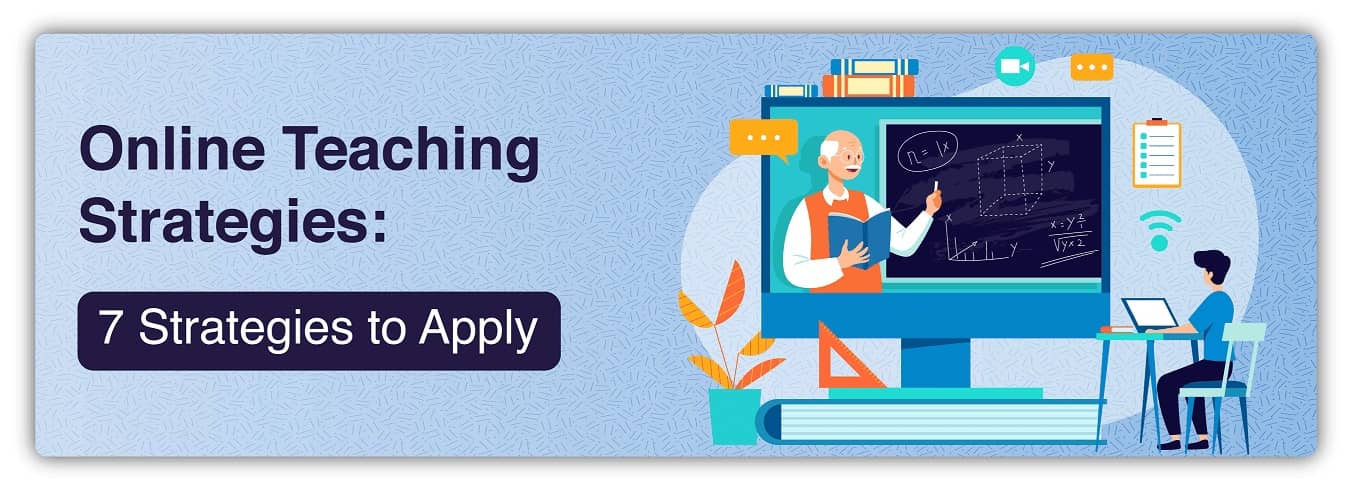


Strategies refer to the plan of action one makes to initiate a task or achieve a goal. Educational planning and management also require designing multiple techniques that serve the learning needs of varied learners. The teaching-learning process involves several steps. Educators curate these steps incorporating numerous activities catering to individual learning needs. However, the teaching-learning process is registering a gradual shift from physical classrooms to online classes. The entire process of learning is using a great deal of technology in some other forms. Be it learning new concepts through videos or taking online quizzes for practice, students and teachers are harnessing technology. Thus, there is a need to develop effective online teaching strategies to obtain maximum learning outcomes.
In this article, we offer some online teaching strategies to employ for delivering better learning experiences.
A traditional classroom involves a child in one-to-one learning. Teachers have control over their teaching and document students' progress. The study material that the teachers deploy plays a crucial role in the conceptual understanding of students. So, an entirely textual study material lacking interactive elements can be a big turn off for them. Such study material fails to hook the students' attention and interest in learning. Ergo, teachers must create teaching strategies that engage the students in online learning.
The simplest method of creating engaging study material is to incorporate online quizzes and offer scholarships reward for students' efforts.
Teaching-learning is an interactive process. Continuous interaction between the teacher and students is essential to ensure a smooth transfer of information. Interactive sessions also initiate healthy conversations among students, teachers, and peers. Students benefit from it as they develop confidence and several other skills.
Also, in a virtual classroom, the teacher cannot engage students with the non-verbal cues so, the students are more likely to disconnect from the class. Therefore, it becomes crucial to conduct interactive sessions when conducting online learning classes. Online quizzes, Gamification, and other engaging activities can help students connect with the concepts and learn better.
Every student follows a different learning pattern and style. Some learners are visual learners while the others are aural learners and so on. Using the same learning tools for every student does not allow uniformity in learning. For instance, a student performs well in online quizzes while the other may find it easy to solve visual puzzles. Therefore, teachers must create online teaching strategies considering the different types of students and their distinct learning needs. A single tool is not viable for performing such dynamic functions. Ergo, it is advisable to employ multiple learning tools in an online class.
Establishing a virtual presence implies maintaining a constant engaging conversation with the students while teaching. Being present on screen is not enough. A teacher must ensure that the students do not perceive the online class to be a monologue. Also, solving student queries is an essential step towards establishing a virtual presence. One of the best ways to do this is by conducting interactive online quizzes and discussions.
Reflection is an essential component of learning. Reflecting upon the learning experience allows the students to understand better. Teachers can keep track of students' progress in learning by recording their experiences. It also helps to identify the learning levels and requirements of the students.
Traditional teaching mainly uses the lecture method for teaching. It does not take into account the learning needs of all the students. The reason being that the lecture method does not work effectively for all. However, modern teaching methods use a variety of tools focusing on creating a dynamic learning environment. Using such tools enables students to learn as per their learning style and preferences. Modern online teaching tools such as Google Classroom allows sharing study materials and assignments, like online quizzes, in different formats. Students and teachers can make effective use of such modern tools in the online teaching and learning process.
Feedback is a crucial element of the teaching-learning process. Student feedback provides an insight into the effectiveness of the teaching methods and the learning needs and levels of students. A teacher must work to create a student-oriented learning environment with a flexible feedback mechanism. It requires a good connection between students and teachers, creating a continuous flow of communication. Once the teacher gets the feedback, it is easier to create and modify teaching strategies according to the student requirements.
Besides the strategies in this article, teachers must ensure the e-learning content is easily accessible. It implies that the students should get access to content via all devices like laptops and mobile phones. Also, teachers must keep a tab on the technological updates and teaching-learning trends to effectively curate interactive lessons. Assessment tests such as online quizzes, MCQs and other assignments can help make online teaching effective.